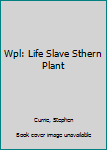Wpl: Life Slave Sthern Plant
(Part of the The Way People Live Series)
Details the living conditions of plantation slaves, examing house, field and artisan work; food and clothing; marriage; separation; resistance; leisure activities; and old age. This description may be from another edition of this product.
Format:Hardcover
Language:English
ISBN:1560065397
ISBN13:9781560065395
Release Date:January 1999
Publisher:Lucent Books
Length:96 Pages
Weight:0.75 lbs.
Dimensions:0.5" x 7.8" x 9.3"
Age Range:10 to 13 years
Grade Range:Grades 5 to 8
Customer Reviews
2 ratings
life of a slave
Published by Thriftbooks.com User , 17 years ago
This book was kind of boring in some parts and exciting in others. The book tells about all of the slaves life and not just when they were field workers. It talks about weddings, religion, punishment, and more. There are many pictures and lots of quotes. I would recommend buying this book!
A balanced account
Published by Thriftbooks.com User , 17 years ago
Today, as 150 years ago, many of us probably think of the antebellum South as being totally dominated by slaveholders, primarily planters. Politically, socially, and economically, to a great extent, it was. But, as author Currie points out at the very beginning of his book, "three of every four white Southerners did not own slaves at all...[and] 90% owned fewer than twenty." As in all else, the "large" slaveholder set the tone for the institution, which is doubtless why Currie decided to concentrate on plantation usages. He covers the different types of field workers (cotton, sugar, rice, tobacco, and hemp), with sketches of the work they did, and the "upper crust" of bond Negro-hood, the house slaves and "yard" (artisan) slaves. He points out repeatedly that there was no single standard for slave treatment that was followed throughout the region: "working conditions varied...[as] did the quality of food, housing, clothing, and medical care they received." And he includes descriptions of both ends of the spectrum. Although he admits that slaves often resorted to sabotage, shamming, and even violence, and doesn't mince words in his description of some of the punishments meted out to slackers, runaways, and other offenses against the good order of the system, he also includes several examples of the deep bonds that could grow up between blacks and their owners, such as one white's reaction to the death of a favorite slave: "...I feel desolate--my most devoted friend is gone..." He also provides lively pictures of the fun slaves had in their time off, everything from dances to communal worship. Like all the books in this series, the volume is abundantly illustrated from original sources (though some of the engravings should perhaps be taken with a grain of salt, since many probably appeared in the abolitionist press) and buttressed by quotes from both black and white Southerners who experienced the system at first hand. Naturally its size and scope prevents it from giving a wide-ranging account of its complex subject, but it does at least provide a balanced, nonrevisionist picture from which the curious reader can move on to more detailed books.





